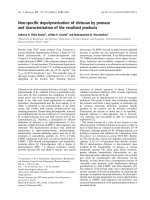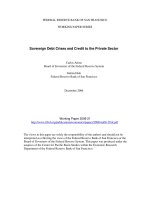What, So What and Now What: the analytic process ppt
Bạn đang xem bản rút gọn của tài liệu. Xem và tải ngay bản đầy đủ của tài liệu tại đây (51.94 KB, 2 trang )
What, So What and Now What:
the analytic process
By Chris Garson
Copyright 2012 Chris Garson
Smashwords Edition
What, So What and Now what. Maybe you’ve heard this before, I certainly didn’t
invent it. I learned the technique twenty years ago while training to facilitate team
building sessions. We used metaphors to train, activities such as sitting back to
back in pairs and describing geometric shapes for partners to draw, or team
exercises in Lego construction. The lessons were always about communication
and understanding team strengths and weaknesses and we used What, So
What, Now What in the debrief to make lessons apparent. We’d begin the
debrief by asking the participants What had happened. Once the observations
were on the table, we followed with So What, an invitation to speculate on the
exercise’s meaning, which set the stage for Now What, when we asked what
from the exercise could be taken back to the workplace.
I wish I knew who did come up with What, So what and Now what so I could give
them proper credit. A quick Google search turned up many articles describing
this debriefing technique as a tool for the experiential learning cycle often used
for parenting and in teaching. I’ve taken the model and adapted it to the
analytical process and developing analytical skills. I’ve trained managers to
assess analytical capabilities using the What, So What and Now What scale and
a quality assurance training program was developed based on these three
questions.
Individuals can be at level 1, 2 or 3 analytical capability, as are specific jobs. The
trick is to match up the analytical capabilities of the individual with the needs of
the job.
Level 1 people are good at gathering data and reporting the facts.
Level 2 people are good at statistics, theory and proof
Level 3 people are good at turning theory into decisions.
In any business, people at all three skill levels are needed. Those operating at a
higher analytical level typically rely on data and speculation provided by the lower
levels. Assess your people’s analytical capabilities against this model and job
needs. If they’re stuck at What, help them get to So What. If they’re stuck at So
What, help them get to Now What. You’ll be glad you did. It will make your job
easier, and you more effective, in the long run.
Any set of good business practices includes reporting measures. One goal of
reporting is to detect process failures and identify areas ripe for improvement, but
what if we’re measuring the wrong thing or reporting it the wrong way? The
What, So What and Now What model is a good measuring stick to assess your
reporting. Here’s how to use this simple model to make sure you’re measuring
and reporting effectively.
For every table of data, every chart or graph, make sure you have answers to
these three sets of questions:
1 – What happened? Is the data clearly labeled? Are units of measurement,
the time period, and data filters visible? Are the axis scaled effectively? Does
the data, chart or graph tell a clear story of what happened?
2 – So what? Data by itself is mildly curious, but has no value until meaning is
attached. What theories spring to mind explaining the results? Why does the
data look this way? Can a process change explain a change in trend? Have
external factors affected the result?
3 – Now what? At the end of the day, managers are paid to make decisions.
What decisions will you make from the data? If the data doesn’t help you
answer this question, then you may not be measuring the right thing.
Ask yourself these three questions for every piece of data you produce. If you
manage others, you can develop them by insisting that they adhere to this
standard. If you do, I guarantee you’ll stop reporting some measures and
discover new things to measure.
A tip – annotate each chart with a sentence or two capturing What, So What and
Now What for the information you’re presenting. It’s simpler than you think. For
example, a chart showing dealership car sales by customer zip code might
include this annotation. “Car sales on the east side climbed for the third month in
a row while the west side stayed flat. We believe this is due to less west side TV
ads running due to the cable company geographic penetration combined with the
approach our advertising agency takes to purchasing. Going forward, we
recommend changing the ad buys as follows ….” A few short sentences
following each chart increases the value of your reporting immensely.









